Ascidiacea (sea squirts)
Life > Eukaryotes > Opisthokonta > Metazoa
(animals) >
Bilateria > Deuterostomia >
Chordata > Tunicata
Twenty-six families, 167 genera and 2852 species
worldwide, with 16 familes, 53 genera and 176 species native to
southern African seas and a further family, genus and seven species
naturalised in the region. Thus, 6.2 % of the world's sea squirt
species have been recorded as native species from southern African
seas.
Classification
Global figures are from
World Register of Marine
Species (WoRMS).
|
Aplousobranchia Thirteen families, 59 genera and
1501
species worldwide, with nine families, 24 genera and 95 species native to southern African
seas, and a further two species that are naturalised in the region. |
|
|
|
Family: Clavelinidae Two genera and 48
species
worldwide, with one genus, Clavelina,
native to southern African seas, where it is represented by three native
species and one that is naturalised. |
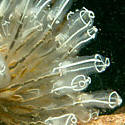 |
|
|
Family: Didemnidae Nine genera
and about 586 species worldwide,
with seven genera and 28 species native to southern African seas and a
further species that is naturalised in the region. |
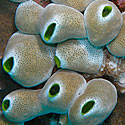 |
|
|
Family: Holozoidae
Nine genera and 102 species worldwide,
with four genera and eight species native to southern African seas. |
|
|
|
Family: Polycitoridae
Nine genera and 190 species worldwide,
with four genera and 17 species native to southern African seas. |
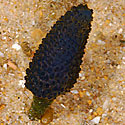 |
|
|
Family: Polyclinidae
Ten genera and 428 species worldwide,
with four genera and 28 species native to southern African seas. |
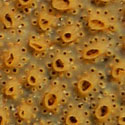 |
|
|
Family: Pseudodistomidae Three genera and
32 species worldwide. One species, Pseudodistoma africanum
(Strawberries), is native to the southern African seas. |
|
|
|
Family: Pycnoclavellidae Two genera and
27 species worldwide, with one genus in southern African seas,
Pycnoclavella, represented by six species. |
|
|
|
Family: Ritterellidae Three genera and 24
species worldwide, with one genus in southern African seas, Ritterella,
represented by three species. |
|
|
|
Family: Stomozoidae One genus,
Stomozoa containing five species. Represented in southern African seas
by one species, Stomozoa roseola. |
|
|
Phlebobranchia Nine families, 40 genera
and 328 species worldwide, with four familes, five genera and 15 species
native to southern African seas and a further family, genus and species
naturalised in the region. |
|
|
|
Family: Agneziidae Five genera and 32
species worldwide, with one genus in southern African seas,
Agnezia, represented by two species. |
|
|
|
Family: Ascidiidae
Five genera and 150 species worldwide, with one genus and eight species
native to southern African seas, and a further genus and species that is
naturalised in the region. |
|
|
|
Family: Cionidae Three genera and 17
species worldwide. No native species in southern African seas but
Ciona intestinalis (Sea vase, Vase
tunicate) has become naturalised in the region. |
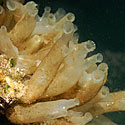 |
|
|
Family: Corellidae Eleven genera and 41 species worldwide, with
two genera and two species native
to southern African seas. |
|
|
|
Family: Perophoridae Two genera and 50
species worldwide, with one genus in southern Africa,
Ecteinascidia,
represented by three species. |
|
|
Stolidobranchia Four families, 68
genera and 1023 species worldwide, with three families, 24 genera and 66
species native to southern African seas and a further four species that are
naturalised in the region. |
|
|
|
Family: Molgulidae Thirteen genera and 226 species worldwide,
with three genera and eight species native to southern African seas. |
|
|
|
Family: Pyuridae
Seventeen genera and 246 species worldwide,
with six genera and 16 species native to southern African seas, and a
further species that is naturalised in the region. |
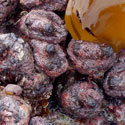 |
|
|
Family: Styelidae
Thirty-six genera and 538 species worldwide,
with 15 genera and 42 species native to southern African seas, and a further
three species that are naturalised in the region. |
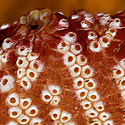 |
Publications
- Monniot C, Monniot F and Griffiths CL. 2001. South African
ascidians. Annals of the South African Museum 108(1): 1-141.
- Picker M and Griffiths C. 2011. Alien and Invasive Animals -
A South African Perspective. Struik Nature, Cape Town.
Text by Hamish Robertson |
